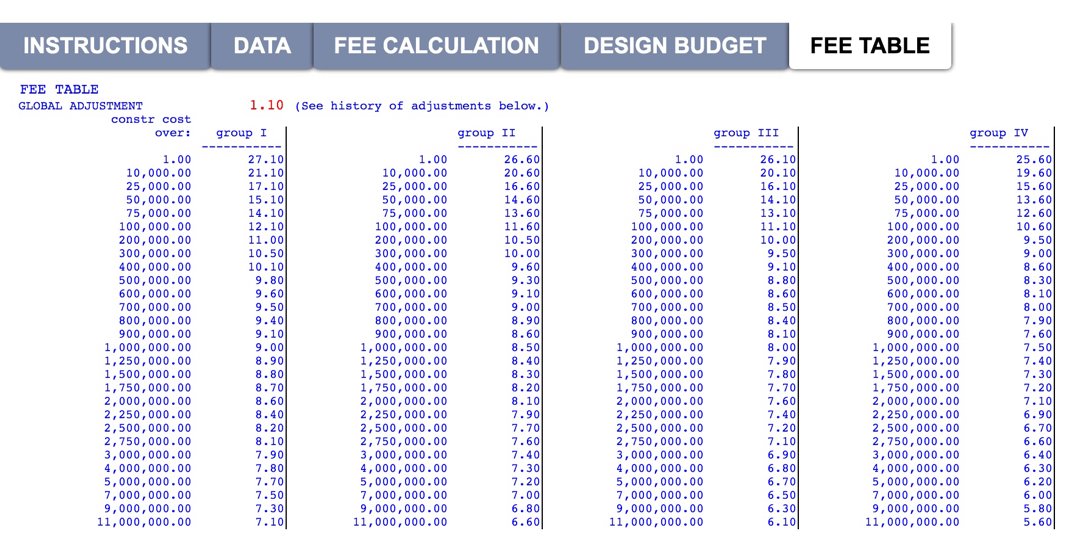Estimating Design Fees
There are probably thousands of ways to estimate design fees. My method has evolved over 30 years into this approach that I am sharing with you.
Estimating design fees is part science and part art (OK...it’s math and guessing). The approach that I use is dictated by the size/complexity of the project, who the competition is, and who the client is.
Before we get into the nuts and bolts, let's dispense with 'competition' and 'client' considerations. These two issues affect what you do about the number that you have arrived at as 'the fee'.
COMPETITION
The larger the firms are that you are competing with the more you can ask for a decent fee because they usually will. By the way, my firm has averaged about six people to give you an idea of my perspective. The closer your competition is to your own size, the more I find that someone will be very low. You will need to go there too, or decide to ask for what you think is fair and distinguish yourself in another way. Say, by showing you really understand them. In any event that low-ball fee will put downward pressure on your own proposal.
CLIENTS
The client plays a part because you can usually tell what they are used to. A developer is used to partial services and won't spend more than he has to. A client with several buildings has learned that you get what you pay for and squeezing the architect's fee is a false economy. So you adjust your fee proposal accordingly.
METHOD 1
So now the to the nuts and bolts. I usually use three methods. First I check my gut feel for what the fee should be (the art). This might be a dollar amount or a percentage that would be applied to the construction cost. My Dad started me on an allowance when I was 11 and I have always been interested in what things cost. So when I say 'art', the truth is more like 'interest plus experience'. I like to use this Method to build my experience, but it is dangerous to stop here.
METHOD 2
Second I run through an exercise of calculating an appropriate fee based on a percentage of construction cost and then modify it by non-standard circumstances. Fee tables have to be based on a specific scope of work, and the scope that is most common is what the AIA documents call Basic Services. In a nutshell this is the five Phases of service: Schematic Design, Design Development, Construction Documents, Bidding, Construction Administration. Basic Services also includes mechanical, electrical, and structural engineering. A fee table also needs to account for the type of project, easy or complex, and the size/cost. The images shown here are the spreadsheets that I use. The spreadsheets contain many formulas and they reference each other and a customized Basic Services Fee Table (Sample here).
METHOD 3
Third, I use a checklist of deliverables to mentally walk through what drawings will be needed. This is pointless on large projects, but very telling on small to mid-size projects. I assemble the list of anticipated drawings and estimate the number of hours that each will require. I add a contingency of 15% to those hours. When you look back at the calculated fee after this exercise, you learn the range that the proposed fee will fall in. Usually this 'check' tells you something about the project that the pure math approach missed.
I find that it is best to let this simmer for a day or two before making a final decision. Most of the time there is a significant variance among the three methods. When I go back and review my three methods, I will always make adjustments, especially in the Excel Workbook. If we win the job, the Workbook will become the Design Budget for the work. The METHOD 3 checklist also becomes part of the project management tools we will use, so I want it aligned with Method 2’s fee allocations. The more experience you have with calculating fees, the more your gut feel (Method 1) will help you get everything in alignment.
Over time, one of the big benefits of this approach is that your process for calculating a fee will get better and better. Once you can standardize the process, you have added real value to your business because a critical part can be delegated with predictable results.
If you would like to explore my Method 2 in detail, the Excel Workbook that I use is available here.





